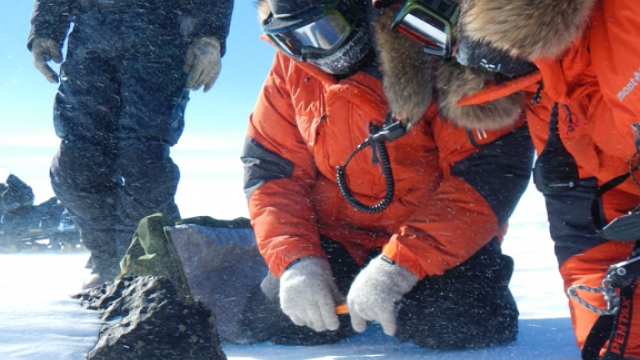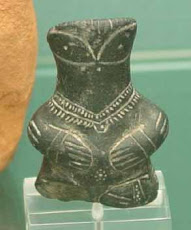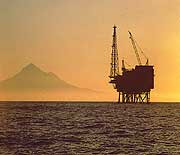skip to main |
skip to sidebar


The Site of Mount Padang is the Evidence of Architectural Masterpieces of Ancient
The results of radiometric analysis of the content of the carbon element in some samples of cement in drill core from the depth of 5-15 meters which was conducted in 2012 at the prestigious Laboratory, BETALAB, Miami, USA in the mid-2012 shows its age with a range between 13,000 and 23,000 years ago.
Previously, the results of carbon dating which carried out in the BATAN laboratory, the dominant quartz sand that fills the voids between the columns of andesite at the depth of 8-10 meters below the terrace of five also showed the same age range is about 13,000 years ago.
Data from drilling conducted by DR. Andang Bachtiar and microscopic analyzes of rocks from drill core samples were carried out by DR. Andri Subandrio, geologist of volcanic rocks of the Petrology laboratory ITB, can be assured that the high resistivity body rock is andesite lava rock, the same rock type as the column of the site of mount Padang.
Another thing that is interesting from petrological analysis is finding of many microscopic cracks in the thin section of andesite stone columns that allegedly non-natural because the cracks cut its constituent mineral crystals.
Danny H. Natawidjaja states that mount Padang has same potency with Borobudur, even it is more meaningful because it can be a breakthrough of knowledge about "the craddle of civilizations" in this century, as a proof of the great monuments of the oldest civilizations in the glorious world that destroyed because of catastrophe thousands of years ago in the pre-history of Indonesia.
"It is not impossible anymore if Indonesia as archipelago nation has civilization as advanced as the ancient Egyptian civilization, even in the much older," Danny said.
 SCIENTISTS AT PRINCESS ELISABETH ANTARCTICA DISCOVER 18KG ANTARCTIC METEORITE
SCIENTISTS AT PRINCESS ELISABETH ANTARCTICA DISCOVER 18KG ANTARCTIC METEORITE.
A team of scientists working at Princess Elisabeth Antarctica has recently discovered a meteorite weighing 18kg embedded in the East Antarctic ice sheet, the largest such meteorite found in the region since 1988.
The eight members of the SAMBA project, from Université Libre de Bruxelles (ULB) and Vrije Universiteit Brussel (VUB), Japan’s National Institute of Polar Research (NIPR) and Tokyo University were searching for meteorites scattered across the Nansen Ice Field on January 28, when they found the 18kg ordinary chondrite. The team discovered a total of 425 meteorites, with a total weight of 75kg during the 40 day expedition, at an altitude of 2,900m, 140km south of Belgium’s Princess Elisabeth Antarctica research base.
“This meteorite was a very unexpected find for us, not only due to its weight, but because we don’t normally find such large meteorites in Antarctica”, said Vinciane Debaille, a geologist from Université Libre de Bruxelles, who led the Belgian team during the expedition. “This is the biggest meteorite found in East Antarctica for 25 years, so it’s a very special discovery for us, only made possible by the existence and location of Princess Elisabeth Antarctica.”
The SAMBA project contributesto the US and Japan-led global collection of Antarctic meteorites, and is an initiative of VUB and ULB, in collaboration with the Japanese Institute of Polar Research. SAMBA is supported by the Belgian Science Policy (BELSPO) and the International Polar Foundation.
Initial field analysis by the scientists suggests that the 18kg meteorite is an ordinary chondrite, the most abundant kind of meteorite. The fusion crust – the meteorite’s outer casing - was eroded, allowing the scientists to inspect the rock underneath. The meteorite is currently undergoing a special thawing process in Japan – to ensure water doesn’t get inside the rock - but will be brought to Belgium in the future.
“We study meteorites in order to better understand how the solar system formed, how it evolved, how the Earth became such a unique planet in our solar system”, said Debaille. “This season’s SAMBA mission was a success both in terms of the number and weight of the meteorites we found. Two years ago, we found less than 10kg. This year, we found so much that we had to call the travel agency – because we had 75kg of meteorites to take home”.
Princess Elisabeth Antarctica is the world’s first zero emission polar research station, and is operated by the International Polar Foundation, in partnership with the Belgian Polar Secretariat. Princess Elisabeth Antarctica’s design and construction seamlessly integrates passive building technologies, renewable wind and solar energy, water treatment facilities, continuously monitored power demand and a smart grid for maximising energy efficiency. Located in East Antarctica’s Sør Rondane Mountains, Princess Elisabeth Antarctica welcomes scientists from around the world to conduct research in this little-studied and pristine environment.
“Both Princess Elisabeth Antarctica and the International Polar Foundation are proud to support the research work of the Belgian and Japanese meteorite team”, said expedition leader Alain Hubert. “By providing solid logistics and field accomodation solutions to scientists working on the ice, we can ensure they can concentrate on what they have come to Antarctica to achieve: unlocking of Nature’s mysteries and broadening understanding of our planet”.
To find out more about science at Princess Elisabeth Antarctica and life in the frozen south, visit Inside the Station – an interactive exhibition that takes visitors on a journey inside Belgium’s zero emission polar research centre - currently taking place at Tour & Taxis, Brussels.
















